
The Swiss rail network is noteworthy for its density, its coordination between services, its integration with other modes of transport, timeliness and a thriving domestic and trans-alp freight system. This is made necessary by strong regulations on truck transport, and is enabled by properly coordinated intermodal logistics.
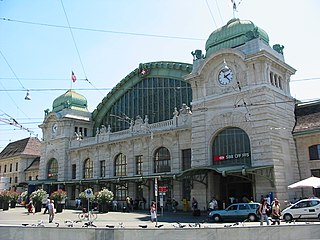
Basel SBB railway station is the central railway station in the city of Basel, Switzerland. Opened in 1854, and completely rebuilt in 1900–1907, it is Europe's busiest international border station. Basel SBB is owned by the Swiss Federal Railways (SBB CFF FFS). The other major railway station is Basel Badischer Bahnhof, operated by the German railway company Deutsche Bahn, on the north side of the Rhine from the city centre.

The Olten–Bern railway line is one of the major railway lines of Switzerland, running between the major rail hub of Olten—where lines from Zurich, Basel, Bern, Lucerne and Neuchâtel come together—and the Swiss capital of Bern. Together with the Lausanne–Bern railway, it forms the Mittellandlinie, which connects Olten with Lausanne. The first part of the line was opened in 1856 and the original line was completed on 4 September 1858. The line was built by the Swiss Central Railway, which was taken over by the Swiss Federal Railways on its establishment in 1902.

Olten railway station is a major hub railway station in the canton of Solothurn, Switzerland, at the junction of lines to Zürich, Bern, Basel, Lucerne and Biel. As a result, Olten is a railway town and was also the site of the main workshop of the Swiss Central Railway, which became a major workshop for the Swiss Federal Railways (SBB CFF FFS). It is the southern terminus of the Basel Regional S-Bahn S3 and S9 lines, the northern terminus of the Lucerne S-Bahn S8 line, and the western terminus of the Aargau S-Bahn S26 line.

The Swiss Central Railway was one of the five major private railway companies of Switzerland. The SCB with a track length of 332 kilometres was integrated into the Swiss Federal Railways (SBB) in 1902.

The Zürich–Baden railway line is a major railway line in Switzerland connecting the cities of Zürich and Baden. It forms part of the major east-west route between Zürich and Olten. The line generally follows the south bank of the Limmat from Zürich to Baden. A new line, the Heitersberg line, opened in 1975, branches off in Killwangen-Spreitenbach and follows a more southerly route through the Heitersberg Tunnel towards Olten. The Zürich–Baden railway is electrified at 15 kV 16.7 Hz and much of it has four tracks.

Lucerne railway station is a major hub of the rail network of Switzerland, in the city of Lucerne in the canton of Lucerne. It is a terminal station serving domestic and international traffic on several rail lines, and is situated in a city centre and waterfront location on the south side of Lake Lucerne.
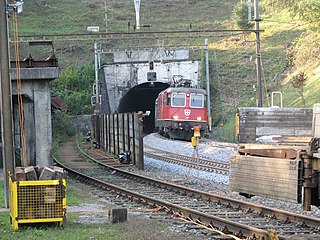
The Bözberg railway line is a railway line in Switzerland, running between Basel and Brugg via Pratteln, Rheinfelden, Stein-Säckingen, Frick and the Bözberg Tunnel. At Brugg it connects to Zürich via Baden and to the Gotthard Railway via the Aargauische Südbahn.
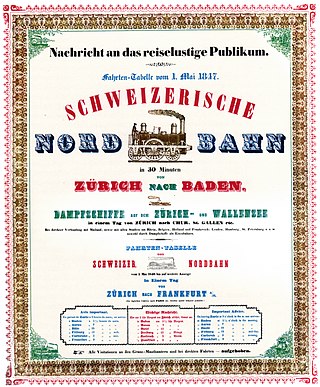
The Swiss Northern Railway , informally known as the Spanisch-Brötli-Bahn, opened the first railway line within Switzerland in 1847, the Zürich–Baden line. This followed the extension of a French railway to Basel in 1844. The original line generally followed the south bank of the Limmat from Zürich to near its confluence with the Aar near Brugg and then it generally followed the south bank of the Aar to Olten. It was absorbed into the Swiss Northeastern Railway in 1853 and extended from Baden to Brugg in 1858. The line was absorbed into the Swiss Federal Railways on its establishment in 1902. It is electrified at 15 kV 16.7 Hz and its eastern 16 km section from Zürich to Killwangen-Spreitenbach is now part of the Zürich–Olten trunkline and has four tracks.
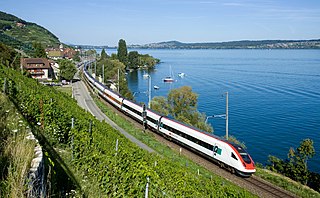
The Jura Foot Line or Jura South Foot Line, is a railway line in Switzerland. It runs from Olten along the foot of the southern Jura range through Solothurn, Grenchen, Biel/Bienne, Neuchâtel, Yverdon-les-Bains and Morges to Lausanne. It is one of two routes used by intercity trains between Geneva and Zürich. The other is the Midland line which connects Olten via Langenthal, Burgdorf, Bern, Fribourg, Lausanne to Morges. The line was built by five railway companies, which after several mergers were absorbed into the Swiss Federal Railways in 1903.

Rail 2000 is a large-scale project of the Swiss Federal Railways (SFR) established in 1987 to improve the quality of the Swiss rail network for the New millennium. It includes measures to accelerate a number of existing connections and the modernisation of rolling stock. The federal government decision to support the project in 1986 was approved by a referendum in 1987. In 2004 the first phase was completed consisting of around 130 projects with a budget of around CHF 5.9 billion.
The construction and operation of Swiss railways during the 19th century was carried out by private railways. The first internal line was a 16 km line opened from Zürich to Baden in 1847. By 1860 railways connected western and northeastern Switzerland. The first Alpine railway to be opened was under the Gotthard Pass in 1882. A second alpine line was opened under the Simplon Pass in 1906.

The Bern–Thun railway line is a double-tracked, electrified railway line that runs through the Aare valley in the Swiss canton of Bern. It is part of the Lötschberg-Simplon axis between Germany and Italy. It was opened in 1859 by the Swiss Central Railway.

Olten–Aarau railway line is a railway line in the north of Switzerland. It runs from Olten along the Aare to Aarau.

The Bernese Jura Railway was a railway company in Switzerland. The company was called the Jura–Bern–Luzern from 1 July 1884. The Jura–Bern–Lucerne merged with the Western Switzerland–Simplon Railways to form the Jura–Simplon Railway (Jura-Simplon-Bahn), JS) on 1 January 1890.
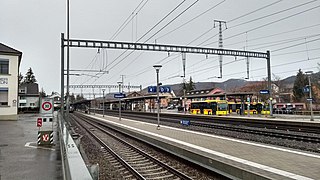
Sissach railway station is a railway station in the municipality of Sissach, in the Swiss canton of Basel-Landschaft. It is an intermediate stop on the standard gauge Hauenstein line of Swiss Federal Railways. At Sissach the Hauenstein line splits; most trains run via the base tunnel to Olten, while Basel trinational S-Bahn S9 trains provide local service over the older summit line.

Sommerau railway station is a railway station in the municipality of Gelterkinden, in the Swiss canton of Basel-Landschaft. It is an intermediate stop on the summit branch of the Hauenstein line and is served by local trains only.
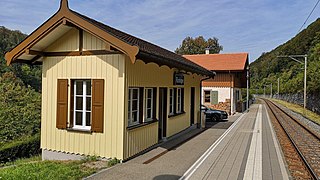
Rümlingen railway station is a railway station in the municipality of Rümlingen, in the Swiss canton of Basel-Landschaft. It is an intermediate stop on the summit branch of the Hauenstein line and is served by local trains only.
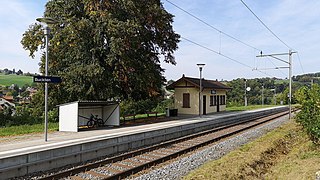
Buckten railway station is a railway station in the municipality of Buckten, in the Swiss canton of Basel-Landschaft. It is an intermediate stop on the summit branch of the Hauenstein line and is served by local trains only.

Läufelfingen railway station is a railway station in the municipality of Läufelfingen, in the Swiss canton of Basel-Landschaft. It is an intermediate stop on the summit branch of the Hauenstein line and is served by local trains only.



















